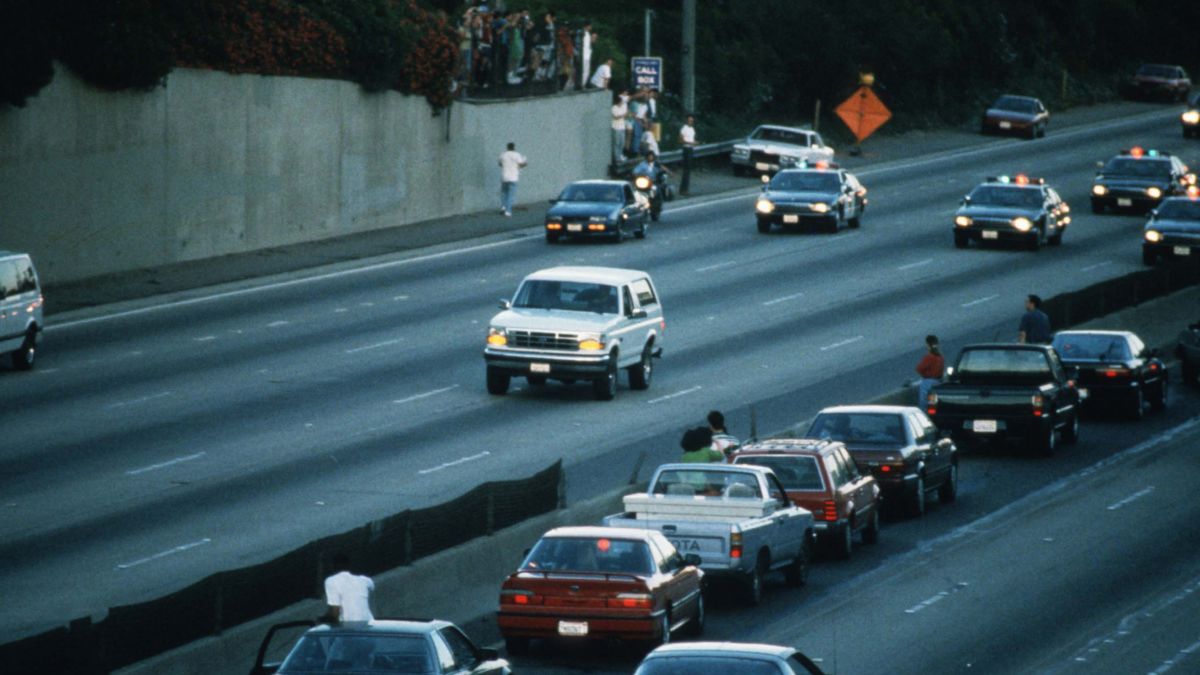
O.J. and L.A.
O.J. Simpson’s death earlier this month marked the end of a tragic trajectory, a long and enduring descent from national hero to pariah. A once beloved figure’s legacy swallowed by his infamous murder trial and subsequent spiral. That precipitous tumble, at least in the public consciousness, all began with his fateful flight along the freeways of Southern California, captured on televisions worldwide. It was also the first time that I, and probably millions more, started to grasp the perplexing urban condition of Los Angeles.
I remember staring, stupefied, at our Sanyo TV, propped up on a chair in the living room. (We never had a TV in the living room. Was it there just for the chase?) It was about a month after my high school graduation. The pursuit was the most surreal thing I’d ever seen. That celebrity footballer barreling down the freeway, making tight lane changes as if he were back at USC, avoiding linebackers. The floating cameras captured his route as if it were a grand prix, or a really good episode of Cops. He sped under overpasses and over underpasses. Past cloverleafs, bridges, streaking trees; atop oil-streaked roads with limitless lanes.
I barely knew L.A. then. We had visited relatives in the Valley when I was quite young, but that was a blur marked in my brain only by isolated destinations like Venice Beach and Universal Studios. Now, even though I didn’t know it, I was learning how the place worked as O.J. streaked through the city’s life blood, its burly freeway system, in that weird white Bronco, escorted by a police phalanx. Traffic bubbled up on the opposite side of the highway. People scattered and cheered like they were at a music festival.
To that point, most of my knowledge of L.A. had come from snippets—pieces of the area produced by Hollywood. A leafy street in the Valley. A party house in the Hollywood Hills. A brutal stretch of Skid Row. A dated office dreamed up by Raymond Chandler. A song and dance on the L.A. River. A glance at the mirrored towers of Downtown L.A. in the intro to L.A. Law. (As for freeways, I knew about CHIPS, but that was before my time.) I could put the rest together in my head, but it wasn’t real. I never got a broad, sustained view—an honest view.
Now O.J. was barreling through the whole SoCal megalopolis on the 5. Past the 605, then the 710, onto the 10 and then the 405. (What were these numbers preceded by “the”?!) First he was in Santa Ana, then in Anaheim, Buena Park, and East Los Angeles. Then in L.A. itself—which, it turned out, was just another city here. Past the control tower at LAX, then Culver City, then Santa Monica. Onto the off-ramp at Brentwood.
Then, suddenly, that speeding ribbon of city transformed into a green oasis of manicured medians and private tennis courts. In a flash, O.J. was back at his mansion. What just happened?
Southern California, I later came to realize, was dominated by this nondescript collection of freeways and interconnected urbanity that had been temporarily brought to life—made a star—by the shouts, honks, and media maelstrom of that day. It never ended. There were no breaks. Just perpetual concrete covering place after place, city after city. But in a snap it morphed into something altogether different. A collection of very real snippets: surprisingly unique destinations and neighborhoods (some, like O.J.’s, much more privileged than others), just beyond the chaos of highways and feeder roads.
When I moved to Los Angeles from New York 10 years later, I rediscovered this phenomenon. I’d be on a quiet residential street, then all of a sudden on a roaring freeway, and just as quickly back into another reality.
When I moved to Los Angeles from New York 10 years later, I rediscovered this phenomenon. I’d be on a quiet residential street, then all of a sudden on a roaring freeway, and just as quickly back into another reality. I had no bearing. It was like landing in a spaceship on another planet. As time progressed, I started to understand how it worked: How to use the mountains to regain my sense of direction. How each off-ramp contained something special, often hidden in plain sight. How the highways laid themselves out a lot like New York’s subways, and how each even had its own personality. How the jarring changes in reality were the essence of Los Angeles. What made it work, made it special: that tenuous, seamless balance between mundanity and humanity. Between placelessness and place.
O.J. had been my guide. He had inadvertently helped introduce me, and many watching him that day, to that unpredictable, shape-shifting collection of off-ramps and private oases that somehow form a thriving megaplace. Now that I’ve spent more than a decade here, I realize that as much as I’d like L.A. to change, this will always be its heart. Yes, we can and must encourage vital improvements to livability and sustainability, like mass transit, smart density, parks, and walkable streets. But L.A.’s fundamental character is set: its disembodied episodes of beauty, fascination, and chaos; its dizzyingly diverse neighborhoods and cities—all simultaneously hidden and sustained by nothing but asphalt across an endless stretch of a seemingly endless city.
O.J. reminded us that fateful day, as many have before and since, that people are not always what we think they are. But our commitments to buildings and infrastructure don’t lie. They reveal, for better or worse, the true priorities of places and cultures. These choices can be softened, improved. But we can’t will away a place’s true nature, just as we can’t will away a person’s.
Featured image via Flickr.
